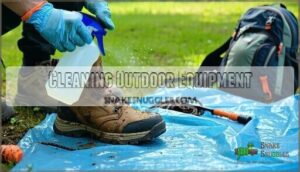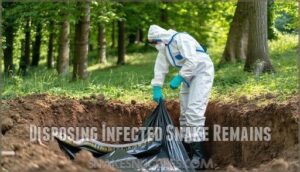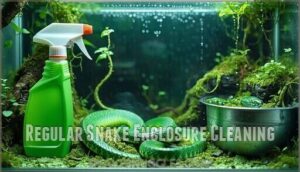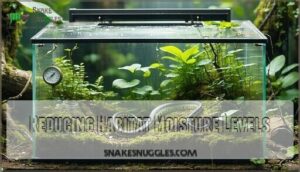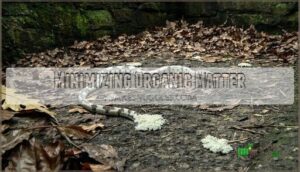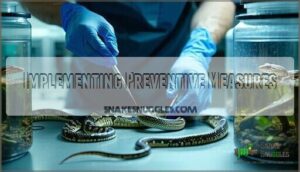This site is supported by our readers. We may earn a commission, at no cost to you, if you purchase through links.
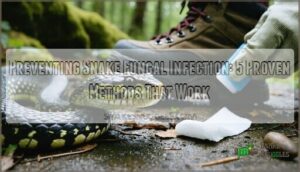
Clean your boots, gloves, and equipment after any outdoor activity where you might encounter snakes.
Don’t handle wild snakes directly – even healthy-looking ones can carry fungal spores.
If you’re a snake keeper, quarantine new animals for at least 90 days and maintain proper enclosure conditions with low humidity and good ventilation.
Report sick snakes to wildlife authorities instead of moving them yourself.
Think of fungal spores like invisible hitchhikers – they’ll travel wherever you take them.
The key lies in understanding how this silent threat moves through snake populations.
It is crucial to consider the impact of human activity on the spread of snake fungal disease, and to take preventative measures to minimize this risk, ultimately relying on proper enclosure conditions.
Table Of Contents
- Key Takeaways
- Minimizing Snake Contact
- Maintaining Hygiene
- Unfavorable Environmental Conditions
- Implementing Preventive Measures
- Community Education Efforts
- Frequently Asked Questions (FAQs)
- How can you prevent snake fungal disease?
- How can I prevent fungal infection permanently?
- How contagious is snake fungal disease?
- How to get rid of fungal infection on snake plant?
- What are early symptoms of snake fungal infection?
- How does snake fungal disease spread?
- Can snake fungal disease affect other animals?
- Are certain snake species more susceptible?
- What treatments are available for infected snakes?
- What causes snake fungal disease exactly?
- Conclusion
Key Takeaways
- Clean your equipment thoroughly – You’ll need to disinfect boots, gloves, and tools with a 10% bleach solution after any outdoor activity where you might encounter snakes, as fungal spores act like invisible hitchhikers that travel wherever you take them.
- Avoid direct snake contact – Don’t handle wild snakes directly, even if they look healthy, since they can carry fungal spores, and maintain at least 6 feet of distance when observing snakes in their natural habitat.
- Maintain proper captive conditions – You’ll want to keep snake enclosures with low humidity, good ventilation, and clean substrates while quarantining new animals for at least 90 days to prevent fungal growth.
- Report sick snakes to authorities – You shouldn’t move infected snakes yourself, but instead, contact wildlife authorities who have proper protocols for the safe removal and treatment of diseased animals.
Minimizing Snake Contact
The best way to prevent snake fungal disease is to avoid touching snakes whenever possible, whether they’re alive, dead, or just their shed skin.
You can also catch this infection indirectly through contaminated soil, so wear gloves when gardening in areas where infected snakes might’ve been, and be aware of the risk of infection.
Avoiding Direct Snake Interactions
Smart snake encounters start with prevention, not reaction.
Avoiding direct snake interactions protects you from snake fungal infection while respecting wildlife naturally.
Here’s your safety checklist:
- Respect Wildlife – Observe snakes from at least 6 feet away
- Avoid Provoking – Never attempt to touch or handle wild snakes
- No Feeding – Don’t offer food that attracts snakes to your area
- Habitat Awareness – Stay alert in areas where snakes commonly live
- Observe Distance – Use binoculars for closer viewing instead of approaching
Preventing Indirect Contact Through Soil
Contaminated soil acts like a silent highway for snake fungal infection, spreading spores long after infected snakes have passed through.
Spores travel invisibly through dirt, infecting new areas long after sick snakes have moved on.
You’ll want to focus on soil composition management and natural barriers around your property.
Apply fungicide treatments to high-risk areas where snakes frequent, and consider soil sterilization techniques for snake care facilities.
Reducing runoff from contaminated areas prevents disease spread to clean zones, making snake fungal prevention more effective.
Safe Snake Handling Techniques
Professional handling prevents snake fungal infection through proper grip techniques and tool usage.
Understanding snake behavior helps you stay safe while minimizing disease transmission risks. Protective gear is essential for handlers.
- Use snake hooks or tongs – Keep distance while maintaining control during handling training sessions
- Apply firm, gentle pressure – Support the snake’s body weight to reduce stress and defensive reactions
- Follow emergency protocols – Have antifungal supplies ready and know when to seek immediate veterinary care
These snake care tips guarantee both handler safety and effective snake infection control.
Educating Public on Snake Safety
Through education, you’ll transform curious bystanders into safety-conscious neighbors.
Teach venomous identification, snakebite prevention basics, and first aid essentials.
Share habitat awareness tips so folks respect wildlife boundaries.
When people recognize snake fungal symptoms and understand proper snake care tips, they become your eyes and ears for infection control.
Knowledge beats fear every time, and by educating others, you ensure that knowledge is spread, helping to prevent and control snake-related issues.
Maintaining Hygiene
You can’t stop snake fungal disease with wishful thinking—proper hygiene practices create real barriers between you and this persistent pathogen.
Don’t let fungal spores catch you off guard—proactive hygiene beats reactive treatment every time.
Whether you’re handling snakes professionally or just maintaining outdoor spaces, these four hygiene strategies will keep fungal spores from spreading and protect both snake populations and human health.
Cleaning Outdoor Equipment
You can’t just rinse and repeat in the context of equipment disinfection after handling snakes or working in areas where reptile fungal infections might lurk.
Clean your gear with a 10% bleach solution, checking material compatibility first. Consider buying the solution for convenience.
Establish a cleaning frequency based on usage—daily for frequent handlers. Store disinfected equipment in dry areas to prevent recontamination.
Always prioritize user safety by wearing gloves during the cleaning process to avoid treating snake fungus on yourself.
Disposing Infected Snake Remains
When dealing with infected carcasses, you can’t just toss them anywhere. Legal Requirements mandate reporting to wildlife authorities and following specific disposal protocols.
Safe Handling requires double-sealed biohazard bags and protective gear. For Burial Depth, dig at least one meter deep with impermeable linings.
Cremation Options include incineration at 850°C to destroy spores completely. Consider also specialized disposal bags for safe handling.
Proper Disinfection Methods prevent snake fungus disease spread.
Personal Hygiene for Snake Handlers
After safely disposing infected snake remains, you’ll need proper personal hygiene to prevent spreading snake skin disease.
Your hands become the main transmission route between infected and healthy animals.
Follow these handwashing techniques and disinfection protocols:
- Scrub hands with antimicrobial soap for 20 seconds after each snake contact
- Apply alcohol-based sanitizer containing at least 70% isopropyl alcohol
- Change protective gear between handling different snakes or enclosures
- Clean any cuts immediately and monitor for signs requiring antifungal treatment snakes
Post-handling hygiene protects both you and your animals from snake health issues.
This process is crucial for maintaining a safe and healthy environment for both you and your animals, emphasizing the importance of handwashing techniques.
Regular Snake Enclosure Cleaning
Clean enclosures weekly using reptile-safe disinfectants to prevent snake fungal disease. Remove waste immediately and replace substrate monthly—dirty bedding breeds trouble.
Scrub water bowls thoroughly, as stagnant water harbors spores. Proper enclosure size reduces stress, boosting immune systems against snake health issues.
Regular cleaning beats expensive antifungal treatment snakes need later. To maintain a sanitary environment, disinfect all accessories regularly.
Unfavorable Environmental Conditions
You can create conditions that make it tough for fungal infections to take hold in snake habitats.
By controlling moisture, temperature, and organic debris, you’ll stack the odds against these nasty pathogens.
Reducing Habitat Moisture Levels
Moisture is like a welcome mat for fungal spores. You’ll want proper ventilation in snake habitats to keep air moving and prevent stagnant, humid conditions.
Install drainage solutions to eliminate standing water that breeds trouble. Choose substrate materials that don’t hold moisture like a sponge.
Strategic sunlight exposure helps dry out damp areas naturally. Smart shelter management means creating dry zones where snakes can escape humidity, preventing snake disease before it starts.
Proper airflow is essential, so consider habitat ventilation products to maintain healthy conditions, ensuring a healthy environment for the snakes.
Maintaining Optimal Temperature
Temperature control plays a bigger role than you might think in preventing snake disease.
You’ll want to create proper heating gradients with designated basking spots for effective thermal regulation.
Monitor temperatures closely and make seasonal adjustments as needed.
Poor temperature monitoring leads to stressed snakes with compromised immune systems, making them vulnerable to fungal infection reptiles commonly face.
Consistent reptile health care includes maintaining ideal thermal zones.
Minimizing Organic Matter
Dead leaves and rotting wood create fungal paradise around snake habitats.
Reduce Leaf Litter regularly, especially during fall cleanup. Control Compost Piles by relocating them away from snake areas. Limit Wood Usage near enclosures—decomposing logs harbor dangerous fungi.
Manage Animal Waste promptly to prevent bacterial growth. Clear Vegetation Debris weekly.
For ideal reptile health, consider mimicking native ecosystems. These steps starve fungi of nutrients they need to thrive and infect snakes, creating a healthy environment and preventing bacterial growth.
Reducing Fungal Spore Dispersal
Fungal spores don’t just sit still—they hitchhike on air currents, equipment, and even you.
Installing airborne spore control systems like HEPA filters cuts transmission by 80%.
Limiting vector spread means controlling what moves between areas: clean boots, sanitized tools, and quarantine protocols work wonders.
Environmental sterilization through UV-C devices and dispersal barrier creation using physical shields help contain outbreaks.
Smart spore viability reduction protects your snakes.
Implementing Preventive Measures
You can’t just hope infected snakes will go away on their own—taking direct action stops the spread before it gets out of hand.
Smart prevention means removing sick animals, setting up clean zones, and keeping a close eye on your snake populations.
Removing Infected Snakes
Beyond controlling environmental factors, you’ll sometimes need to remove infected individuals from populations.
Safe relocation requires proper handling protocols and professional expertise to prevent spreading spores.
When dealing with infected snakes, follow these containment protocols:
- Professional Removal – Contact wildlife specialists for safe capture and transportation
- Handling Risks – Always wear gloves and disinfect equipment between uses
- Euthanasia Options – Severely affected snakes may require humane disposal by veterinarians
- Antifungal Treatment Snakes – Mild cases benefit from snake vet care and targeted snake skin treatment
Professional snake disease prevention teams understand treating fungal disease nuances better than untrained handlers.
Creating Fungus-Free Zones
Several key strategies help you establish sterile environments where fungal spores can’t survive.
Sterilize substrates using UV sterilization or heat treatment before introducing snakes. Install air purification systems with HEPA filters to remove airborne spores.
Create antifungal barriers using specialized disinfectants around enclosures. Smart habitat design includes non-porous surfaces that resist fungal growth, preventing reptile skin problems before they start.
Quarantine Protocols for Captive Snakes
You’ll want to isolate new snakes for 60-90 days minimum.
Set up dedicated enclosures with individual tools to prevent cross-contamination. Monitor symptoms weekly, checking for skin lesions and behavioral changes.
Use 10% bleach for disinfection methods between handling sessions. Reduce stress by minimizing handling frequency.
A thorough initial assessment is essential for identifying underlying issues. This isolation duration catches reptile skin problems before they spread throughout your collection.
Monitoring Snake Populations
Beyond quarantine measures, you’ll need to track your local snake communities regularly.
Monitor population density changes and conduct health assessments during peak activity seasons.
Watch migration patterns in natuurreservaten and Belgische natuurreservaten, as overcrowded areas increase fungal infection reptiles risks.
Document genetic diversity and habitat monitoring data to spot early warning signs of preventing reptile disease outbreaks before they spread.
Community Education Efforts
You can’t fight snake fungal disease alone—community education creates the strongest defense network.
When everyone knows how to spot symptoms and handle snakes safely, we stop infections before they spread through local populations, forming a strongest defense.
Educating Public on SFD Symptoms
Once your preventive measures are in place, you’ll need to help your community spot trouble early.
Recognizing SFD symptoms isn’t rocket science – look for white patches, crusty skin, or unusual shedding patterns on snakes.
Early detection saves lives, so teach folks that symptom variation exists across species.
Create visual guides showing healthy versus infected reptiles, and establish clear reporting protocols.
When someone spots potential fungal infection reptiles in Belgian nature areas, they’ll know exactly who to call, protecting our Belgian natural heritage through preventing reptile disease.
Promoting Safe Snake Handling
Teaching folks proper snake handling keeps everyone safe while protecting these remarkable creatures. When people know what they’re doing, fungal infection reptiles become less common through better practices.
Safe handling basics:
- Handling Gear – Always wear gloves and use proper tools like snake hooks for Bite Prevention
- Expert Training – Learn from wildlife professionals before attempting any snake interaction
- Snake Welfare – Support the snake’s body properly and minimize stress during contact
Responsible Handling protects both you and the snake. In Belgische natuurparken, proper natuurbescherming means respecting wildlife while staying safe. Remember, confident handling reduces stress for everyone involved – including the snake!
Encouraging Community Reporting
Community reporting turns everyday citizens into snake-health detectives, creating early-warning networks that protect entire ecosystems.
You’ll strengthen natuurbescherming efforts when communities actively participate in reptile fungal prevention initiatives.
Setting Up Effective Reporting Systems
| Component | Implementation | Benefits |
|---|---|---|
| Reporting Incentives | Offer recognition, small rewards, or certificates for documented cases | Increases participation in natuurbeschermingsprojecten |
| Anonymity Options | Provide online forms, hotlines, and drop-box locations for shy reporters | Protects data privacy while encouraging Belgische natuurparken monitoring |
| Rapid Response | Establish 24-48 hour acknowledgment system with follow-up updates | Builds trust and maintains public awareness momentum |
Collaborating With Local Authorities
Working with wildlife agencies strengthens your community’s defense against snake fungal disease.
Local authorities maintain 24/7 hotlines for reporting protocols and coordinate emergency response teams. Their resource allocation includes mobile quarantine units and testing supplies.
Legal frameworks now support temporary restrictions in high-risk areas, ensuring public safety through proven reptile fungal prevention strategies that protect both snakes and residents, which is crucial for the community’s public safety.
Frequently Asked Questions (FAQs)
How can you prevent snake fungal disease?
Keep outdoor gear clean, disinfect hands and tools between snake handling, and maintain separate equipment for wild versus captive reptiles to prevent spreading the fungal disease.
How can I prevent fungal infection permanently?
You can’t prevent fungal infections permanently, but you’ll dramatically reduce your risk by maintaining good hygiene.
Keeping skin dry, avoiding shared personal items.
And strengthening your immune system through proper nutrition and sleep.
How contagious is snake fungal disease?
Snake fungal disease spreads moderately between snakes through direct contact, shared environments, and contaminated surfaces.
You’ll find it’s not highly contagious like viruses, but infected snakes can transmit spores to healthy ones through close proximity, which can lead to the spread of the disease.
How to get rid of fungal infection on snake plant?
Remove affected leaves immediately, improve drainage, reduce watering, increase air circulation, and apply a fungicide if needed. You’ll stop the spread and save your plant.
What are early symptoms of snake fungal infection?
Healthy snakes sport smooth, glossy scales while infected ones develop localized scabs and crusty, thickened skin lesions.
You’ll notice facial swelling first, then blisters, cloudy eyes and lumps under the skin.
Laboratory diagnosis often requires PCR for identification to confirm the presence of snake fungal disease, which can be identified through this laboratory diagnosis.
How does snake fungal disease spread?
Think twice, it spreads through direct contact with infected animals or contaminated environments.
You’ll see transmission through contaminated surfaces like soil, rocks, or vegetation.
Courtship, mating, and shared dens amplify the risk.
The disease is linked to population decline in wild snakes.
Can snake fungal disease affect other animals?
Horrifyingly, this fungal nightmare isn’t just limited to serpents.
The fungus can also be transferred from mother to babies, but research shows it’s primarily snake-specific.
You won’t catch it spreading to mammals.
Are certain snake species more susceptible?
You’re absolutely right that some snake species show different vulnerability levels.
While rattlesnakes initially seemed most prone to severe infections, this likely reflects heavier monitoring rather than true susceptibility differences.
Most snakes are likely susceptible to SFD, but research shows infection patterns appear randomly distributed across species rather than following clear evolutionary lines, indicating a complex relationship between species and infection patterns.
What treatments are available for infected snakes?
Like traversing a medical maze without a clear map, treating infected serpents proves challenging.
Antifungal medications haven’t worked well in colubrid snakes, though supportive care with food, shelter, and water helps.
What causes snake fungal disease exactly?
A fungus called Ophidiomyces ophiodiicola causes snake fungal disease.
You’ll find this pathogen thriving in soil and organic matter, then infecting snakes through skin wounds or respiratory passages during stressful conditions.
Conclusion
Remember, an ounce of prevention‘s worth a pound of cure in the context of snake health.
You’ve learned five key strategies for preventing snake fungal infection that’ll protect both wild and captive populations.
Start with basic hygiene – clean your gear after outdoor activities and avoid handling wild snakes.
Maintain proper enclosure conditions with low humidity and good ventilation for captive animals.
Report sick snakes to authorities rather than moving them yourself, as these simple steps create barriers against fungal spread and keep snake communities healthier for generations to come.
- https://chateaudechimay.be/
- https://visitwallonia.be/nl/content/fort-en-memoriaal-van-hoei
- https://walloniebelgietoerisme.be/nl/119/brochures?utm_source=newslettertouring&utm_medium=email&utm_campaign=touring2021
- https://cwhl.vet.cornell.edu/article/everything-you-wanted-know-about-snake-fungal-disease-were-afraid-ask
- https://royalsocietypublishing.org/doi/10.1098/rstb.2015.0457

